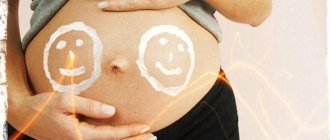34th week of pregnancy: your baby's development
The baby continues to grow, and there is less and less space in the uterus for him to tumble. As a result, you may notice that your baby is not moving as intensely. But you still feel his stretching and movements, they just happen with less amplitude. At 34 weeks, your baby may move lower into the pelvis in preparation for birth. A doctor's exam or ultrasound this week or in the coming weeks may show that the baby has turned head down in the uterus in anticipation of labor. Are you curious what color your baby's eyes will be when he's born? Eye color depends on the amount of melanin pigment. Babies born with little or no pigment will have blue eyes. However, this may change within the first year or two. If your baby's eyes are dark at birth, they are less likely to change color. Read more about when children's eye color changes. The planned date of birth is getting closer. Have you already prepared everything for the meeting with your baby? Take our test to find out how ready you are. For expectant mothers of boys: the baby's testicles may have already descended into the scrotum. Sometimes it happens that one or both testicles do not descend at the time of birth, and this happens around the sixth month.
Lifestyle
Several weeks have already passed since the baby was first able to distinguish the voices of his family. And if now he hears his mother’s gentle voice, he smiles back. Let conversations with your baby at 34 weeks not seem strange to you - researchers have long proven that the fetus in a woman’s womb understands speech addressed to it, and during such a “conversation” the rhythm of its little heart becomes even and calm. But parents' quarrels make the baby's heart beat much faster. Experts also do not recommend that pregnant women get carried away listening to loud melodies with a lot of low frequencies and harsh sounds - this will injure the child’s fragile nervous system. A win-win option is classical music (Mozart, Vivaldi, Tchaikovsky).
What happens to the mother's body at 34 weeks of pregnancy
34 weeks of pregnancy - how many months is it? The period of 34 weeks is equal to the full eighth obstetric month and two more weeks. In the coming weeks, be vigilant for possible signs of preterm labor. Premature birth is considered to be labor that begins before the 38th week of pregnancy. Premature birth is a cause for concern because babies born very early are at high risk of health problems due to poor development. Signs of premature birth include:
- Nagging pain in the lower abdomen, accompanied by or without diarrhea
- heavy vaginal discharge
- change in vaginal discharge (for example, discharge becomes watery, bloody, or contains a lot of mucus)
- incessant dull pain in the lower back
- regular or frequent contractions
- rupture of amniotic fluid (water may pass in a strong stream or leak slowly)
If you are expecting twins, it is important to be especially attentive to these signs. In multiple pregnancies, the risk of premature birth is 50% higher than in singleton pregnancies. If you have questions, be sure to ask your doctor. And perhaps you will find an article about the development of twin pregnancy week by week useful.
Beauty and accessories
Women during this period often complain of hair loss and brittle nails. This happens due to a lack of calcium in the body. Increase the consumption of fermented milk products in your diet, but do not overdo it - excess calcium, we repeat, can now lead to severe ossification of the child’s skull and reduction of the fontanel.
Try to wear cotton underwear rather than synthetic. And don't forget about the prenatal bandage, especially if you continue to lead an active lifestyle.
34th week of pregnancy: symptoms
Here are the symptoms you may experience during your 34th week of pregnancy:
- Braxton-Hicks contractions.
As your due date approaches, training contractions, or Braxton-Hicks contractions, may become stronger and more regular. If contractions occur at varying intervals and go away when you change position or move, then most likely these are training contractions and there is nothing to worry about. But if you think you're experiencing labor contractions, contact your doctor right away. The best judge of whether these are labor or training contractions is your doctor. You may also find our article useful, which describes the differences in sensations during labor and training contractions.
- Breast augmentation in volume.
Towards the end of the third trimester, your breasts may become even more noticeably larger. As a result of stretching, the skin may itch. Moisturizing lotions have probably already become a must-have part of your self-care rituals—regular use of moisturizers can help reduce itchy skin. A properly fitted bra with good support can provide comfort. The straps of such a bra should be wide and adjustable, and the belt should have several rows of hooks. In the first months after your baby is born, you may want to loosen the straps and loosen the waistband. Find out more about how breasts can change during pregnancy.
- Pain in the pelvic area.
At 34 weeks, as your baby drops lower in anticipation of labor, you may experience mild pelvic pain, lower back discomfort, or pressure on your bladder. But at the same time, due to the change in the baby's position, the pressure on the diaphragm and lungs decreases and it may become easier for you to breathe. If you experience pain in this area, try not to stand for long periods of time. Try taking a warm bath, this may provide some relief. If the pain persists and bothers you, consult your doctor.
- Swelling of ankles and feet
. During the later stages of pregnancy, many expectant mothers experience swelling in their feet. Try to spend as little time standing as possible, and when sitting, place your feet on an elevated platform.
- Constipation
. Constipation can occur for various reasons. But whatever the reason, constipation can cause great discomfort for the expectant mother. What to do? Drink plenty of water, eat plums or prunes and foods rich in fiber: fruits, vegetables, whole grain bread and bran cereal. Walk, do exercises - physical activity stimulates the digestive system. And one more tip: eat small meals several times a day.
Predisposition factors
The occurrence of twin pregnancy can be facilitated by:
- heredity - the presence of twins in relatives of partners or one of them. More common across generations. Moreover, the relatives may not be close - first cousins or second cousins;
- during pregnancy occurring after 35 years of age - the older the woman giving birth, the higher the chances;
- at the end of taking COCs, the ovaries begin to actively produce hormones, which is why several zygotes can form;
- hormonal stimulation during IVF - more than one artificially grown embryo is transported into the uterus. If two eggs are detected during pregnancy, then one can be removed if desired (resorption);
- history of several births. According to statistics, during the fourth pregnancy, every third woman in labor is diagnosed with multiple births (the so-called parity of pregnancy).
Options for the development of monozygotic twins
34th week of pregnancy: what to look for
- Older children may have a hard time adjusting to having a baby at home because of all the changes that come with it. At first, parents focus on preparing for the birth of the baby, and after the baby is born, they spend all their time caring for him. As a result, older children may become jealous. However, parents can make it easier for them to get used to the new reality and prepare older children for joining the family. Discuss your pregnancy with your children in an age-appropriate manner. There are special children's books that talk about where children come from. You might find one of these books useful for conversations with older children. Involve older children in preparing for the birth of the baby - this will help them get used to the idea that a new family member will soon appear. For example, they can help with choosing and purchasing the right things for the baby. It will also be useful to discuss with older children before birth what kind of help you can expect from them with the baby. And be sure to spend one-on-one time with your older children so that they understand that they are still loved and valued.
- Calcium helps build and strengthen your baby's bones and teeth, and getting enough calcium during pregnancy is essential for the health of both baby and mom. Calcium may be included in prenatal vitamins, but this does not eliminate the need to include foods high in calcium in your diet: dairy products, leafy green vegetables (such as broccoli), and calcium-fortified juices. Learn more about how much calcium a woman needs during pregnancy and ask your doctor if you're getting enough calcium. Your doctor may recommend taking calcium supplements or adjusting your diet.
- The last thing you want to worry about when you go into labor is what to take with you to the hospital. That's why we've compiled a complete list of necessary things in the maternity hospital so you can pack your bag in advance. The list includes things you, your partner, and your new baby will need.
- If you have some free time this week, consider making a few meals and freezing them. A ready-made lunch that just needs to be heated will be very useful in the first time after the birth of the baby. You may also appreciate the convenience of grocery delivery - you can arrange regular delivery now. Or one of your family and friends will bring you home-cooked food in the first weeks after you return from the hospital.
- If you haven't already, consider what methods of labor pain relief you would like to use. Check with the doctor who will deliver the baby what methods will be available to you. As a rule, this can be medical pain relief, such as epidural anesthesia, and non-medical methods: massage, breathing techniques, etc.
Good to know
Why does the baby lie incorrectly in the stomach and how to turn it over?
Placental abruption: delay is unacceptable!
Premature babies: care in the maternity hospital
How to massage the perineum against tears
Placenta - during pregnancy and after childbirth: what you need to know
How does female sexuality change during pregnancy?
All texts for pages about mother and baby were kindly provided by RAMA Publishing - these are chapters from the book by Svetlana Klaas “Your Favorite Little Man from Conception to Birth”, reviewer Irina Nikolaevna Kononova, Candidate of Medical Sciences, Associate Professor of the Department of Obstetrics and Gynecology of the Ural State Medical Academy (Ekaterinburg).
34th week of pregnancy: what to ask your doctor
- What position is the baby in now?
- In the case of breech presentation, what are the chances that the baby will have time to turn over before birth?
- If the baby still remains in the breech position closer to birth, what does the doctor recommend?
- What exercises or stretches can you do to relieve pressure on your lower back?
- Can your doctor recommend neonatal CPR training that you could take?
Survey
Pregnancy with twins is confirmed using ultrasound examination already at 5-7 weeks of gestation. Fraternal fruits are usually identified earlier than identical fruits. Doctors should warn the couple that it is extremely rare, but still there is a phenomenon called hidden twin syndrome (ischiopagus) - one more developed embryo absorbs the other. Then, during the following diagnostic procedures, a singleton pregnancy is displayed on the ultrasound monitor screens. Also, with incomplete separation, it is possible for twin organisms to join each other (Siamese twins). Modern diagnostic methods make it possible to establish as accurately as possible the fact of twin pregnancy. But the expectant mother should be aware of the risks associated with such a gestation. Thanks to the Doppler system that studies blood flow, an experienced diagnostician can determine the beating of two hearts at once.
A blood test shows an elevated level of an embryo-specific marker - alpha-fetoprotein (AFP), and a reduced iron concentration. Chorionic gonadotropin is higher during pregnancy with twins, and sharp jumps are observed. If a test system is used to determine pregnancy, then due to the concentrated hCG, the control strip will be richer in color. A medical examination and measurements of the uterine fundus show significant expansion of the uterus, which is not typical for normal pregnancy. An obstetrician-gynecologist can palpate two heads.









